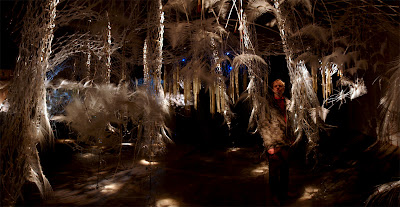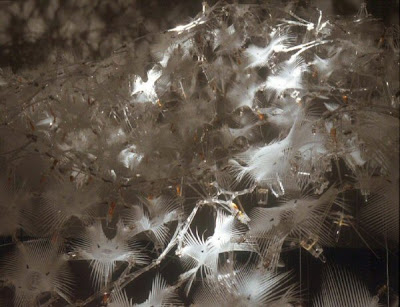I could imaging entering Hylozoic Ground and being simultaneously mystified and disturbed by it’s layered, undulating, featherlike structures. As I hypotheticly wander through the installation, the surfaces reach out to caress and respond to my movement, and little motors and actuators make insect like noises. The architect/artist states that this installation is an experiment in architecture, a responsive sculpture, and art. Without knowing anything about the piece before entering it, I think that the neural network connections of the various surfaces would be apparent, simply by their reaction to my presence. I would find this a little creepy, but knowing no harm could come from it, I would be intrigued to reach out and interact. For this reason, and the visual complexity of the sculpture, I find it very successful in it’s implementation. There are underlining ideas that the architect is also trying to bring to light. He is trying to push the boundaries of what architecture is and what it’s employed to do. Can it breath and remove toxins in the air? Can it understand your mood and empathetically try to enhance it? In other words, can architecture care about it’s inhabitants and it’s environment? I would have to be skeptical say no before seeing this piece. But Beesley transmits the possibilities of such a world through his work, to serious practitioners of architecture and laymen alike, by creating a landscape of living columns, breathing tapestries, and toxin converting canisters.
In another installation, Beesley continues to blur the boundaries between environment, structure, and organism. Orgone Reef is an attempt to characterize what a living wall could be like. While much less elaborate than Hylozoic Ground, he still displays much detail and depth in his thinking. The pattern employees a Penrose Tessellation, a type of Aperiodic Tessellation. While Hylozoic Ground worked for me in it’s monochromatic color scheme, creepy sounds, and complexity, Orgone Reef is much too clear of an idea to be as interesting. If a wall could be living, why would it be like this? The structure itself is modeled after a reef, but also seems a little drab and unresponsive. A little too unconnected. Maybe Orgone Reef was an experimental step to Hylozoic Ground. In any case, Beesley’s work seems to be half research project, and half artistic work. He displays an optimistic view of what the future of architecture could be, and that it happens to looks and act more and more like nature. You could classify most art as man’s interpretation of nature in one way or another.


I can see how you would feel a little creeped out by it responding back to your movements but I think it is so cool! I did not get creeped out by this peice at all. I felt like it's structure brought this mystical feel to it and the lights were just a bonus.
I agree with you on how the Orgone Reef feels a little drab, I think if he placed it differently and added color like a coral reef looks it would really attract people and myself to the peice more.